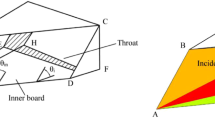Abstract
A numerical study is conducted to determine the effectiveness of six different microvortex generator geometries in controlling swept shock wave/boundary-layer interactions. The geometries considered are base ramp, base ramp with declining angle of \(45\,^{\circ }\), blunt ramp, split ramp, thick vanes, and ramped vanes. Microvortex generators with a gap were found to be better suited for delaying the separation. Thick vanes showed the largest delay in separation among the devices studied.













Similar content being viewed by others
References
Gaitonde, D., Knight, D.: Numerical investigation of bleed on three-dimensional turbulent interactions due to sharp fins. AIAA J. 29(11), 1878–1885 (1991)
Micro-vortex generators enhance aircraft performance. NASA fact sheet (FS-2000-06-52-LaRC) (2000)
Babinsky, H., Li, Y., Pitt Ford, C.: Microramp control of supersonic oblique shock wave/boundary layer interactions. AIAA J. 47(3), 668–675 (2009)
Lu, F.K., Li, Q., Liu, C.: Microvortex generators in high-speed flow. Progr. Aerosp. Sci. 53, 30–45 (2012)
Panaras, A.G., Lu, F.K.: Micro-vortex generators for shock wave/boundary layer interactions. Progr. Aerosp. Sci. 74, 16–47 (2015)
Anderson, B.H., Tinapple, J., Surber, L.: Optimal control of shock wave turbulent boundary layer interactions using micro-array actuation. In: 3rd AIAA Flow Control Conference, San Francisco, CA, AIAA Paper 2006-3197 (2006)
Holden, H., Babinsky, H.: Effects of microvortex generators on separated normal shock/boundary layer interactions. J. Aircraft 44(1), 170–174 (2007)
Lee, S., Loth, E.: Supersonic boundary-layer interactions with various micro-vortex generator geometries. Aeronaut. J. 113(1149), 683–697 (2009)
Lee, S., Loth, E., Babinsky, H.: Normal shock boundary layer control with various vortex generator geometries. Comput. Fluids 49(1), 233–246 (2011)
Li, Q., Liu, C.: Declining angle effects of the trailing edge of a microramp vortex generator. J. Aircraft 47(6), 2086–2095 (2010)
Martis, R.R., Misra, A., Singh, A.: Effect of microramps on separated swept shock wave/boundary layer interactions. AIAA J. 52(3), 591–603 (2014)
Martis, R.R., Misra, A.: Effect of height of microvortex generators on swept shock wave boundary layer interactions. CEAS Aeronaut. J. 4(3), 315–326 (2013)
Ghosh, S., Choi, J.I., Edwards, J.R.: RANS and hybrid LES/RANS simulations of the effects of micro vortex generators using immersed boundary methods. In: 30th Fluid Dynamics Conference and Exhibit, Seattle, Washington, AIAA Paper 2008-3728 (2008)
Weiss, J.M., Smith, W.A.: Preconditioning applied to variable and constant density flows. AIAA J. 33(11), 2050–2057 (1995)
Shih, T.H., Liou, W.W., Shabbir, A., Yang, Z., Zhu, J.: A new \(k\)-\(\epsilon \) eddy viscosity model for high Reynolds number turbulent flows: model development and validation. Comput. Fluids 24(3), 227–238 (1995)
Rodi, W.: Experience with two-layer models combining the k-\(\epsilon \) model with a one-equation model near the wall. In: 29th AIAA Aerospace Sciences Meeting, Reno, NV, AIAA Paper 1991-0216 (1991)
Launder, B.E., Sharma, B.I.: Application of the energy-dissipation model of turbulence to the calculation of flow near a spinning disc. Letter Heat Mass Transf. 1(2), 131–138 (1974)
Wolfshtein, M.: The velocity and temperature distribution in one- dimensional flow with turbulence augmentation and pressure gradient. Int. J. Heat Mass Transf. 12, 301–318 (1969)
Kim, K.S., Lee, Y., Alvi, F.S., Settles, G.S., Horstman, C.: Skin-friction measurements and computational comparison of swept shock/boundary-layer interactions. AIAA J. 29(10), 1643–1650 (1991)
Lu, F.K., Settles, G.S.: Upstream-influence scaling of sharp fin interactions. AIAA J. 29(7), 1180–1181 (1991)
Lu, F.K.: Quasiconical free interaction between a swept shock and a turbulent boundary layer. AIAA J. 31(4), 686–692 (1993)
Settles, G.S., Lu, F.K.: Conical similarity of shock/boundary layer interactions generated by swept and unswept fins. AIAA J. 23(7), 1021–1026 (1985)
Acknowledgements
The authors are thankful to the Vice Chancellor, Defence Institute of Advanced Technology (DIAT), Pune, India, for constant encouragement and support. The authors also thank the Department of Computer Engineering and the Department of Aerospace Engineering, DIAT, for the infrastructural support provided in conducting this study. The authors gratefully acknowledge Holger Babinsky of Cambridge University for providing results of his experiments and for useful suggestions.
Author information
Authors and Affiliations
Corresponding author
Additional information
Communicated by F. Lu and A. Higgins.
Rights and permissions
About this article
Cite this article
Martis, R.R., Misra, A. Separation attenuation in swept shock wave–boundary-layer interactions using different microvortex generator geometries. Shock Waves 27, 747–760 (2017). https://doi.org/10.1007/s00193-016-0690-8
Received:
Revised:
Accepted:
Published:
Issue Date:
DOI: https://doi.org/10.1007/s00193-016-0690-8




